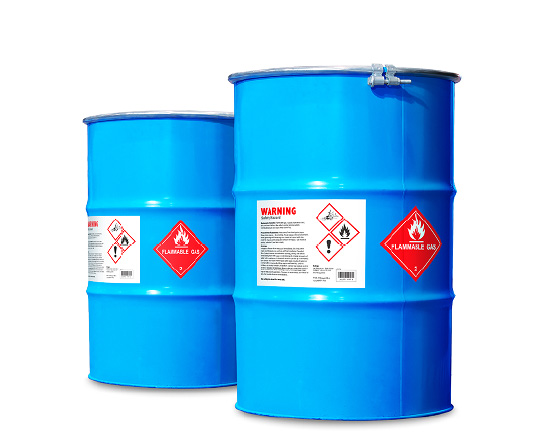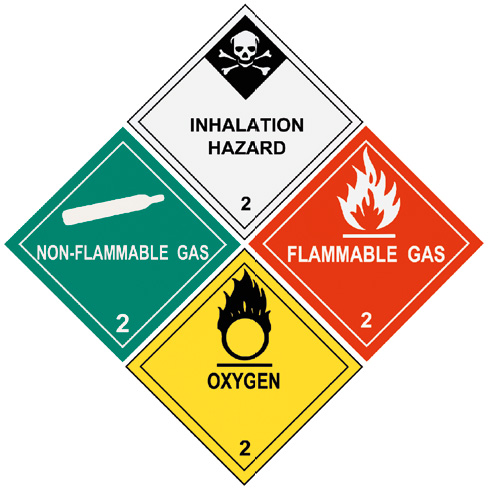
Transporting Dangerous Chemicals:
why are regulations in place?
Oil spillage and chemical leakage from dumped freight are still current and heavily debated topics when discussing transportation of chemicals. The implementation of strict transport regulations helps safeguard health, safety and the environment. Such international regulations ensure that clear standards and requirements apply to the label and label material. Direct labelling of the package showing the contained substance is the first identifier of a dangerous chemical. To comply with regulations, it is important that the hazard is visible at all times and easily recognizable by the trained professional handling the materials in the chemical container. This applies even when the chemical drum or container has been recovered from the sea.
What is the British Standard 5609 (BS 5609) certification?
British Standard 5609 is widely recognized as the most intensive testing protocol for printed labels, and it is also generally known, in the label industry, as one of the highest standards for label durability. BS 5609 establishes specifications and test methods to determine whether pressure-sensitive, adhesive-coated labels will perform under marine conditions. The four-section standard includes two technical sections:- Section two covers the base material of the pressure sensitive, adhesive-coated label – the facestock/adhesive combination. The label stock material is submerged in seawater for three months, testing the label’s performance when submerged.
- Section three covers the final printed pressure-sensitive, adhesive-coated labels, including the printing inks, ribbons and systems applied to materials that were certified in Section two. Printed labels are tested for print key effectiveness, legibility, print permanence, resistance to abrasion and weathering from light, salt spray and sand.
How does BS 5609 classify within the international and European regulatory frameworks?
To understand BS 5609 standard and its origins, it is necessary to look into the two regulations that form its background: The United Nations’ “Globally Harmonised System” (GHS) and the International Maritime Organization’s “International Maritime Dangerous Goods Code” (IMDG). With the international adoption of GHS, labels are required to contain certain universal elements to communicate hazard warnings, safety precautions and pictograms. This is to ensure proper handling of dangerous chemicals around the world. The IMDG Code is a global system developed by the International Maritime Organization to govern the safe transport of dangerous goods by sea. IMDG also requires that labels of dangerous goods meet certain durability standards to withstand the harsh conditions of marine transport. Specifically, IMDG requires labels to withstand three-month marine immersion. BS 5609 includes this test, and establishes durability standards for printed pressure-sensitive, adhesivecoated labels used in marine environments.

What are the label requirements for shipment according to GHS?
GHS is a general directive for the classification of chemicals. Packaging and labelling requirements are also described. A correct GHS label must have the following aspects:- Hazard pictograms (red framed, diamond-shaped)
- Signal words – either DANGER or WARNING
- Hazard statements (H-statements)
- Precautionary statements (P-statements)
- Product identifier (name, CAS#, etc.)
- Supplier identification and contact information
What are the label requirements for shipment according to the IMDG Code?
The International Maritime Dangerous Goods (IMDG) Code is the guide to all aspects of handling dangerous substances and marine pollutants in sea transport. The IMDG Code as originally amended was recommended to governments as the basis for national regulations. After some amendments, the Code is now mandatory. It lays down detailed recommendations for individual substances, materials and articles: good operational practices, including advice on terminology, packaging and labelling: stowage, segregation and handling: and emergency-response action. 1 With a focus on labelling, IMDG classifies dangerous substances by their properties to determine how they should be handled, packaged, loaded, transported, unloaded and stored. The goal is minimizing environmental and safety damage from chemical containers lost or damaged at sea: if a chemical container washes onto shore, its BS 5609-certified label will remain intact to communicate critical information regarding how to handle the contents. Within IMDG, chemicals are classified according to the IMO classification system. There are 9 classifications, each of which require their own dual-coloured, diamond-shaped label.
As well as, being classified correctly, the label should be readable at all times. Both GHS and IMDG require labels that can endure the extreme environment that sea transportation might entail, such as resistance to seawater and exposure to sunlight. Even when the drum/container has been submerged in seawater, the label should be readable:
…affixing packages containing a harmful substance shall be such that this information will still be identifiable on packages surviving at least three months’ immersion in the sea.To meet the requirements of GHS and IMDG, the testing protocol British Standard 5609 (BS 5609) was developed by the British Standards Institution. In addition, BS 5609 compliance is sometimes requested, by the label converters or end users, when extra durable labels are needed, even when a shipment is not going by sea.
